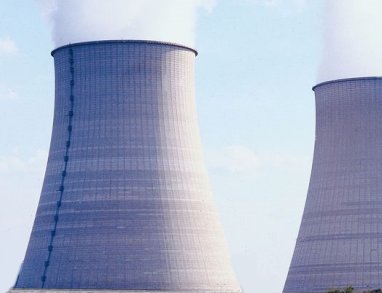If the cooling of the reactor core fails, the decay heat gradually evaporates the existing water in the reactor pressure vessel. The fuel heats up to fusing temperature, it comes to the core meltdown when the heat exceeds the melting point of at least one nuclear fuel element.
The melted mass from the destroyed fuel elements collects itself in the lower part of the reactor pressure vessel. If sufficient mass accumulates, the core meltdown melts itself through the wall of the reactor pressure vessel and enters the reactor containment. This container is part of the reactor building and has the task to safely hold the radioactive inventory in case of an incident. If the reactor containment is not laid out against a core meltdown, it fails and radioactive substances from the melted core are released into the environment.
Radioactive Substances Contained in the Fuel Elements
During a core meltdown radioactive substances contained in the destroyed fuel elements like uranium, plutonium and fission products like for example krypton, strontium, and cesium are set free.
- Gaseous materials, (e.g., noble gases such as krypton and xenon) are set free completely or almost completely during a destruction of the reactor containment. This is valid also for easily volatile materials such as iodine and cesium.
- Less volatile materials such as strontium, uranium and plutonium are present as dust particles (aerosols) or are bound to dust particles. Whether the entire inventory of these materials is discharged or only parts and how far these are transported, depends on the concrete process of the core meltdown.
The weather conditions such as wind force, wind direction and precipitation are determining the preventive measures for the population.
Mixed Oxide (MOX) Fuel Elements
Mixed oxide (MOX) fuel elements, as assigned in the reactor 3 power station of Fukushima I, do not only contain uranium, but also some percent plutonium as fuel. In the enterprise of the reactor plutonium is always formed from the uranium, so also pure uranium fuel elements contain plutonium after some time. However, in a reactor, which is loaded with MOX fuel elements, the core contains two- to five-times as much plutonium as a reactor core containing uranium and operating for a considerable time. In addition, the core contains much higher portions of transuranic elements after some time of operation such as neptunium, americium and curium.
During a core meltdown also larger quantities of these materials are set free and can enter the environment. Like uranium, also plutonium, neptunium, americium and curium are present as dust particles or are bound to dust particles.
All these materials are only set free to a considerable extent from the melt at temperatures well above 2,000 °C. The differences between an uranium nucleus and a MOX core play a rather small role for a core meltdown accident regarding the effects on the environment according to the BfS.
Reference
- Bundesamt für Strahlenschutz (BfS), Salzgitter, Germany (in German; accessed March 30, 2011)
Also of Interest




